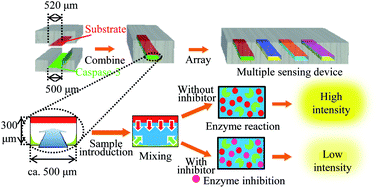Efficient immobilization of the enzyme and substrate for a single-step caspase-3 inhibitor assay using a combinable PDMS capillary sensor array†
Abstract
The caspase-3 inhibitor assay, which is important for drug development was successfully integrated into a “single step” by solving the immobilization problem of enzymes with low activity. Here we used the soluble polyethylene glycol (PEG) coatings for enzyme immobilization to the concave-shaped PDMS surface, and substrate immobilization to the convex-shaped PDMS surface. Then these PDMS structures were combined to form a capillary-structure, which we call a combinable poly (dimethylsiloxane) (PDMS) capillary (CPC) sensor, enabling simultaneous immobilization of two different reactive reagents such as enzymes and fluorescent substrates. The present sensor was disposable, and the fluorescence response was simply obtained by introducing the sample solution by capillary action. The caspase-3 activity was able to be maintained at approximately 90% under −80 °C storage conditions even after 5 months. Importantly, the total reaction time was reduced from an hour to 3–5 min, and simultaneous acquisition of multiple data sets required to determine IC50 value was also successfully achieved using the CPC sensor array.


 Please wait while we load your content...
Please wait while we load your content...